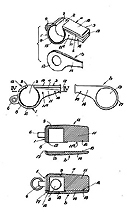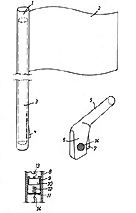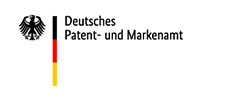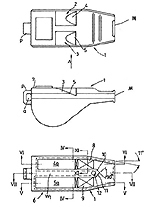The whistle and other signalling devices
1. The whistle and other signalling devices
1.1 The development of the whistle
The whistle is obviously the most striking tool of a referee besides the red and yellow cards. However, whistles are not only used in football matches or other sports but also in many other fields. They are used eg. by the police, railway personnel and rescue services, previously also by the postal services. Contrary to the shoes or the player's outfit, the whistle need not be specifically adapted to the football game.
A ball-free brass whistle (see Figure 1a) was first blown in a football match at the Nottingham Forrest Football Club in 1878. It had been manufactured by the toolmaker Joseph Hudson, who was fascinated with whistles. Patent specification GB 1885-435 describes a similar ball-free whistle from that period. This type of whistle was shortly afterwards replaced by the ball whistle which was much louder.
It was again Joseph Hudson who developed the first ball whistle in the late 1860s. Hudson was a passionate amateur violinist. One day, he dropped his violin. As the instrument hit the floor it gave out a curious, discordant note as the bridge and the strings broke, and Joseph Hudson eagerly tried to manufacture whistles producing that sound.
He developed a whistle where a small pea-sized pellet was inserted in an air chamber (which is why these whistles were called "pea whistles"). The swirling of the pea in the chamber produced the characteristic trilling sound. The astonishing loudness of the pea whistle made it an interesting instrument for the London police force and soon replaced the formerly used signalling hand rattles. Shortly afterwards, the whistle was used in football matches. Figure 1b shows the assembly of a whistle casing from the year 1936. After insertion of ball 4, the two halves of the casing are fitted together (rib 11 seating itself on shouldered part 10) and secured by means of eyelet 9. Ring 6 allows to attach the whistle to a chain or lanyard.

![]() Figure 1c: Assembly of a plastic whistle from 1946 according to GB 620,720. The casing (11) is closed by a lid (13), secured by means of a pin (18)
Figure 1c: Assembly of a plastic whistle from 1946 according to GB 620,720. The casing (11) is closed by a lid (13), secured by means of a pin (18)
This pea whistle was continually improved over the years and also made of plastic (Figure 1c). It is still known under the original name, "Thunderer", and constitutes the most popular whistle.
The drawback of pea whistles lies in the mechanical properties of the sound determining ball. If you blow too hard, the pea can jam and you will only get a high squeaking note or no sound at all. Because of this drawback, inventors tried to develop a pealess whistle producing a comparable blowsound and loudness level. The solution was a whistle provided with two chambers, tuned to slightly different frequencies. It produced a loud blowsound which was very similar to the trilling effect of a pea. Most of today's referees use these pealess whistles, called "Tornado".
EP 1 020 844 describes such a pealess whistle from the year 1999: two sound chambers (2, 3) with air vents (4, 5) are separated from each other by a narrow wall W1, provided with inclined faces at a 45° angle for directing the air flow (see Figure 1d). The blowing pressure required to generate a sound pressure level of 90 DbA is only 0.5 p.s.i.. Another alternative solution is the so-called "strident" whistle whose characteristic note is generated when an air flow is sliced.
It would lead too far to give a more detailed presentation of the general technical development of whistles. Since pea whistles are used in many different areas, patent documents on whistles rarely mention football matches. The patent specifications listed in the table provide some typical examples of whistles with different types of sound chambers and different sound profiles.
| Publication number | Year | Title | Brief description |
|---|---|---|---|
| EP 1 020 844 A2 | 2000 | Whistle | Modern pealess whistle with two sound chambers generating a 90 DbA sound level at a blowing pressure of just 0.5 p.s.i. |
| GB 620,720 | 1946 | Improvements in Mouth-whistles | Method for manufacturing plastic whistles |
| GB 447,673 | 1936 | Improvements in the Manufacture of Mouth Whistles | Simplified method for manufacturing conventional pea whistles |
| GB 1885-435 | 1885 | Improvements in Police and other Whistles | Early brass whistle, originally developed for the police forces, but also used in football matches |
1.2. Specific types of whistles and alternative signalling devices
Over the years, many whistles have been developed which present specific features that make them particularly suitable for use in football matches.
First of all, there are measures for easier carrying of whistles, such as attachment rings for fastening chains or lanyards. Today, we still find new patent applications for specific bracelets or brackets that allow to wear the whistle conveniently on the wrist. For enhanced grip, the side parts of whistles are sometimes roughened or grooved.
A very original and handy idea concerns the choice of sides before the match, which is normally determined by tossing a coin. Instead of the coin, patent DE-PS 855 816 proposes a small dice with two differently coloured faces, lodged in a separate chamber of the whistle.
A mouthpiece has been described as a whistle accessory, to protect the mouth from contact with cold metal whistles in the winter season. Another original design for producing a sound without actually blowing the whistle consists in mounting a rubber bulb on the whistle, which is squeezed if required.
Patent literature also contains some proposals for compressed-air whistles. A Swiss patent from the year 1975 describes a compressed-air operated, hand-held whistle with integrated stopwatch (CH 591 135). Another patent document describes a hand-held pistol-shaped pressure cartridge, connected to a horn carried on the body. As an alternative this document proposes to design the hand-held device as a radio operated transmitter unit connected to an acoustic signalling device. This arrangement allows to transmit and amplify the signal via several loudspeakers in noisy, crowded stadiums. Smart transmission systems allow nowadays to automatically recognise the sound of the whistle and to activate the transmitter only when the whistle is blown (DE 195 06 257 A1).In addition to the mentioned concept of transmission of the whistle signal to the stadium loudspeakers and its amplified reproduction it has been proposed to signal the sound of the referee's whistle by optical means using display elements provided on the sidelines. For this purpose, the whistle is equipped with a piezoelectric pressure sensor with radio transmitter that detects the blowing of the whistle and transmits an activating signal to the display elements (US 2006/0180073 A1).
It has also been suggested that the referee?s whistle be equipped with a microphone and that loudspeakers be installed at the four corner flags (DE 202 04 738 U1).
DE 10 2014 010 135 A1 describes a "smart" sports whistle: It contains a distance measuring unit to control the distance of a wall in the event of a freekick in football matches and a display to show the distance value.
| Publikationsnummer | Jahr | Titel | Kurzbeschreibung |
|---|---|---|---|
| DE 10 2014 010 135 A1 | 2016 | Sportpfeife zur Entfernungsmessung | |
| US 2006/0180073 A1 | 2006 | Whistle and whistle notification device | Trillerpfeife mit einem in die Resonanzkammer eingebauten Drucksensor mit Radiosender, der beim Betätigen der Pfeife ein Aktivierungssignal an optische Anzeigelemente aussendet |
| DE 202 04 738 U1 | 2003 | Schiedsrichterpfeife mit Mikrophon zur Tonverstärkung über die an den 4 Eckfahnen eingebauten Lautsprechern | |
| US 6,416,379 B1 | 2000 | Whistle | Trillerpfeife mit Gurt zur Befestigung am Handgelenk |
| FR 2 793 152 A1 | 1999 | Sifflet manuel | Betreiben einer Trillerpfeife mit einem unter Druck stehenden Ballon |
| US 6,109,490 | 1998 | Wrist Mounted Whistle | Speziell ausgebildetes Armband für die Befestigung einer Trillerpfeife am Handgelenk des Schiedsrichters |
| DE 195 06 257 A1 | 1995 | Verfahren und Anordnung zur Übertragung von Schiedsrichterinformationen bei Rundfunk- und Fernsehsendungen | Übertragungssystem, dessen Sendeeinheit auf ein Trillerpfeifensignal hin aktiviert wird |
| US 5,086,726 | 1990 | Whistle | Schiedsrichterpfeife mit seitlich aufgerauter Wandung für verbesserte Griffigkeit |
| CH 591 135 A | 1975 | Schiedsrichterpfeife | Mit Druckluft betriebene Handpfeife mit integrierter Stoppuhr |
| DE-OS 1 913 936 | 1969 | Akustische Signalanlage | Pistolenförmiges Handsignalgerät, das mit Druckluft betrieben wird |
| DE 1 652 758 U | 1952 | Lippenschutz an Triller- oder Signalpfeife aus Metall | Mundstück zum Schutz der Lippen beim Gebrauch metallischer Trillerpfeifen im Winter |
| DE-PS 855 816 | 1951 | Schiedsrichterpfeife | Klassische Trillerpfeife, die für die Platzwahl noch eine zweite Kammer mit einem zweifarbigen Würfel enthält |
| GB 213,487 | 1923 | Improvements relating to Whistles | Trillerpfeife mit Befestigungsring für eine Kette |
1.3 Communication between match officials

![]() Figure 2: Assistant referee's flag (DE 1 993 964 U, filed in 1968, whose stick (1) contains a transmitter unit (3).
Figure 2: Assistant referee's flag (DE 1 993 964 U, filed in 1968, whose stick (1) contains a transmitter unit (3).
As early as in 1968 an inventor had the idea to use radio transmission of acoustic signals as a means of communication between the referee and the assistant referees. For this purpose, a transmitter unit was incorporated in the hollow stick of an assistant referee flag (see Fig. 2).
The flag stick can be equipped with different mechanisms for activating the transmitter unit, such as a switch (4 and 7) or a drop weight (10). Such flags with transmitter units have been used in professional football matches since the beginning of the 21st century, ie. roughly 30 years after the initial proposal.
Whereas the early systems used narrow band frequency modulation and were rather interference-prone, signals are nowadays encoded for transmission in the UHF band. This reduces the interference rate significantly and allows to receive signals from several persons and to identify the transmitting person. Another recent example provides for an additional optical signal, visible for everybody, in addition to the radio communication between the referee and the assistant referees. LEDs are incorporated in the assistant referee flag for this purpose, which flash when the transmitter unit is actuated.
| Publication number | Year | Title | Brief description |
|---|---|---|---|
| EP 0 941 750 A1 | 1998 | Signalvorrichtung, insbesondere für die Verständigung von Schiedsrichtern | Signalling device for the communication between referee and assistant referees, operated in the UHF band and allowing to identify the transmitting person |
| US 6,067,013 | 1998 | Method and Device for Indicating a Referee Signal | Assistant referee's flag with transmitter unit and LEDs, emitting an optical signal when the transmitter unit is actuated |
| DE 31 20 584 A1 | 1981 | Signalvorrichtung für Sport-, insbesondere Fußballschiedsrichter | Assistant referee's flag with transmitter unit and associated portable receiver unit for the referee. |
| DE 1 993 964 U | 1968 | Sendevorrichtung zum Signalisieren von Zeichen | Assistant referee's flag with hollow stick containing a transmitter unit. The transmitter unit is activated by means of a lever, switch or drop weight |



